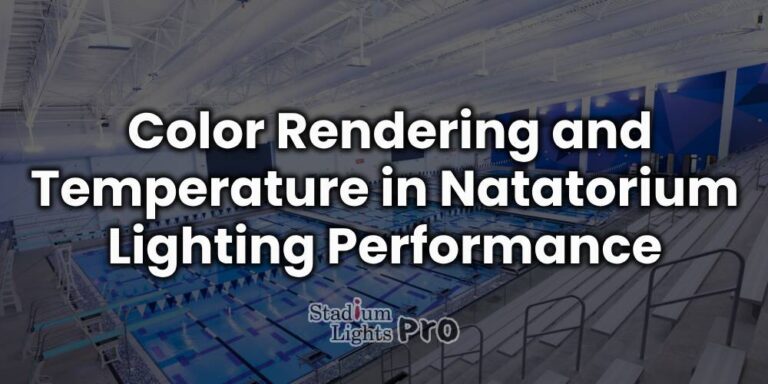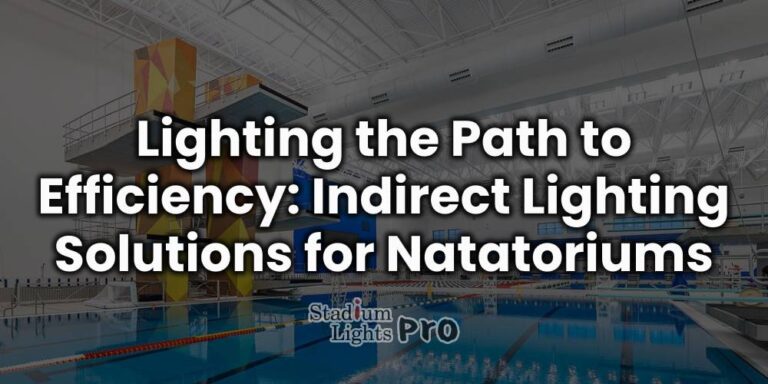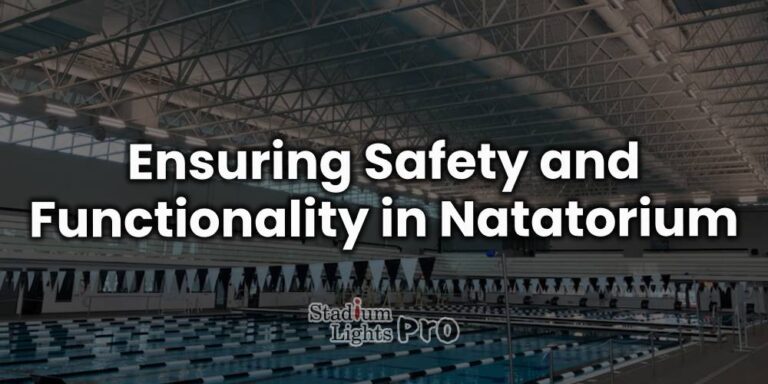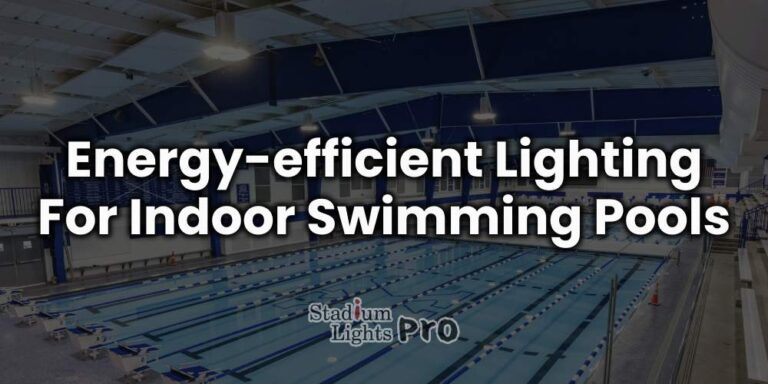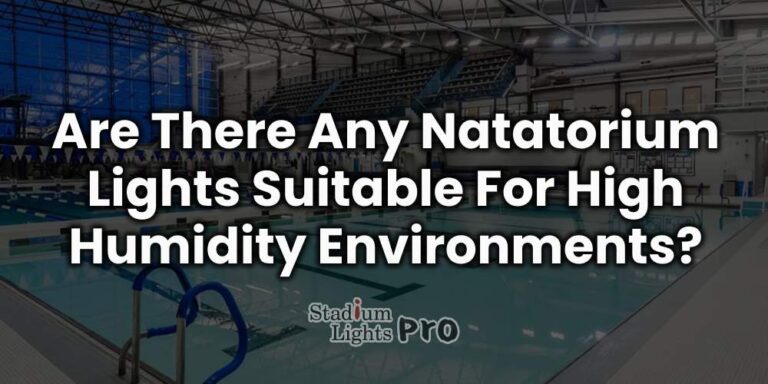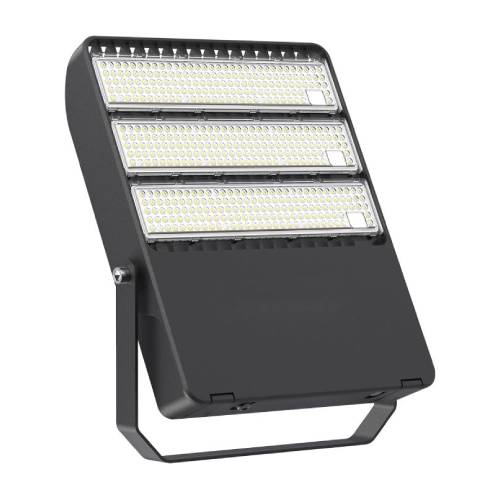
Natatorium Lighting
Step into our comprehensive guide on Natatorium Lighting, where we embark on a journey to illuminate the depths using the latest in LED technology. Plunge into the captivating realm of aquatic illumination as we uncover the transformative capabilities of LED lighting within natatoriums. Here, we offer an in-depth exploration of the myriad benefits and key considerations inherent in LED lighting for indoor swimming pools. From its energy-efficient performance to its remarkable longevity, LED lighting stands as a beacon of innovation, enhancing visibility, ambiance, and safety in aquatic environments. Join us as we shed light on the unparalleled advantages and cutting-edge features that make LED lighting the cornerstone of modern natatorium design.

When purchasing natatorium lighting, it’s crucial to prioritize fixtures that offer waterproofing, corrosion resistance, and optimal visibility while minimizing glare and light pollution. LED technology stands out for its energy efficiency, longevity, and versatility, making it an ideal choice for natatoriums. Consider factors such as waterproofing ratings, glare-reducing optics, and integrated control systems to ensure the best lighting experience for swimmers and spectators while minimizing maintenance costs and environmental impact.
Contact us for a free lighting consultation
Table of Contents
ToggleWhat are the benefits of LED natatorium lighting?
In recent years, there has been a significant shift towards the adoption of LED lighting systems in various applications, including natatoriums. Natatoriums, commonly known as indoor swimming pools, pose unique lighting challenges due to their high humidity, corrosive environment, and the need for consistent and uniform illumination. LED technology has emerged as a promising solution to address these challenges while offering numerous benefits in terms of energy efficiency, longevity, and design flexibility.
The Challenges of Natatorium Lighting
Humidity and Corrosion
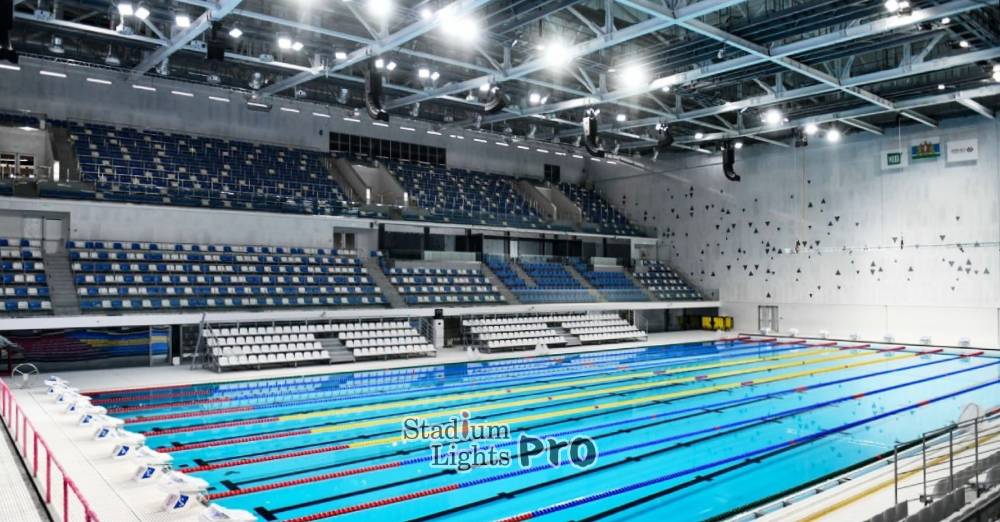
Natatoriums, with their high humidity levels and corrosive atmospheres from chlorine and water treatment chemicals, present significant challenges for traditional lighting fixtures like incandescent and fluorescent lights. These fixtures often succumb to corrosion and degradation, necessitating frequent maintenance and replacement, which can incur substantial costs. The corrosive environment accelerates the degradation process, posing safety risks as fixtures become unstable over time. To address these issues, specialized lighting solutions resistant to corrosion, moisture ingress, and heat buildup are often employed, ensuring prolonged durability, reduced maintenance needs, and enhanced safety for natatorium patrons and staff.
Uniform Illumination
Uniform illumination is crucial in natatoriums to guarantee the safety of swimmers and enhance the visual experience for all. Inconsistent lighting can result in glare, shadows, and areas of low visibility, heightening the potential for accidents and discomfort among athletes and spectators alike. Achieving uniform illumination not only minimizes these risks but also promotes a more enjoyable and immersive environment for everyone involved, fostering optimal performance and enjoyment during aquatic activities. Advanced lighting designs and fixtures tailored to natatoriums are often employed to ensure even light distribution throughout the space, mitigating potential hazards and maximizing safety and comfort for all users.
Energy Consumption
Natatoriums inherently require substantial energy consumption for lighting, heating, and ventilation to maintain optimal conditions for swimmers and spectators. Implementing energy-efficient lighting solutions becomes paramount in mitigating operational costs and lessening environmental impact. By adopting energy-efficient lighting technologies such as LED fixtures, natatoriums can significantly reduce their electricity usage while still providing adequate illumination for activities.
Additionally, incorporating smart lighting controls and sensors further enhances energy savings by optimizing lighting levels based on occupancy and natural light conditions. These measures not only contribute to cost savings but also align with sustainability goals, reducing carbon emissions and overall environmental footprint associated with natatorium operations.
Advantages of LED Lighting in Natatoriums
Durability and Resistance to Corrosion

LED lighting fixtures stand out for their resilience in harsh environments, such as those found in natatoriums, where high humidity and corrosive gases prevail. Unlike traditional lighting technologies like incandescent or fluorescent lights, LEDs are engineered without fragile components such as filaments or glass tubes, rendering them exceptionally resistant to damage caused by moisture and chemicals. Their robust construction and sealed designs prevent moisture ingress and corrosion, ensuring long-lasting performance even in challenging conditions. This durability not only minimizes maintenance needs but also enhances safety by reducing the risk of fixture failure. Furthermore, the superior energy efficiency of LEDs contributes to overall operational cost savings, making them an ideal lighting solution for natatoriums seeking to optimize performance, longevity, and sustainability.
Uniform Illumination
LEDs excel in providing superior light distribution capabilities, granting precise control over beam angles and intensity levels, which is pivotal in natatorium environments. With advanced optical designs and customizable configurations, natatoriums can achieve uniform and consistent illumination throughout the entire pool area, effectively eliminating glare and minimizing shadows. This uniform lighting not only enhances the safety of swimmers by ensuring clear visibility but also improves the overall visual experience for spectators. By strategically positioning LED fixtures and adjusting their settings, natatoriums can create an immersive and comfortable environment conducive to aquatic activities and events. Additionally, the ability to tailor light distribution to specific areas within the pool enhances flexibility in accommodating various activities and events, further optimizing the functionality and versatility of the space.
Energy Efficiency
LED lighting stands out for its remarkable energy efficiency, offering natatorium operators substantial cost savings. Compared to traditional lighting sources, LEDs consume up to 80% less energy, making them an economically savvy choice. Additionally, LED fixtures produce minimal heat output, alleviating the strain on HVAC systems and contributing to even greater energy efficiency. This dual benefit not only reduces operational expenses but also aligns with sustainability goals by minimizing electricity usage and carbon emissions. As a result, natatoriums can enjoy enhanced financial savings while simultaneously reducing their environmental footprint, making LED lighting a compelling investment for long-term efficiency and sustainability.
Longevity and Low Maintenance
LEDs boast an impressive lifespan of up to 50,000 hours or more, far surpassing the relatively short lifespan of incandescent and fluorescent lights. This exceptional longevity translates to significantly reduced maintenance requirements and downtime for natatoriums, enabling them to prioritize seamless service provision to patrons. With less frequent need for bulb replacements, natatorium operators can allocate resources more efficiently, avoiding disruptions to swimming schedules and activities. Moreover, the prolonged lifespan of LEDs contributes to overall operational efficiency and cost-effectiveness, making them an attractive lighting solution for natatoriums seeking to optimize performance and minimize maintenance expenses over the long term.
Design Flexibility and Aesthetics
LEDs provide unmatched design flexibility, empowering natatoriums to craft dynamic lighting effects and ambiance tailored precisely to their requirements. With RGB (Red, Green, Blue) LEDs, natatoriums can achieve captivating color-changing capabilities, elevating the visual allure of swimming pools for diverse occasions like recreational events, competitions, and special gatherings. Whether it’s creating a vibrant atmosphere for an energetic swimming session or setting a serene mood for a relaxing swim, the ability to adjust lighting colors and intensity adds a new dimension to the overall experience for both swimmers and spectators. This flexibility not only enhances the aesthetic appeal of the natatorium but also amplifies its versatility, enabling it to adapt seamlessly to various activities and events, ultimately enriching the overall enjoyment and engagement of patrons.
Implementation Considerations
Lighting Design and Layout
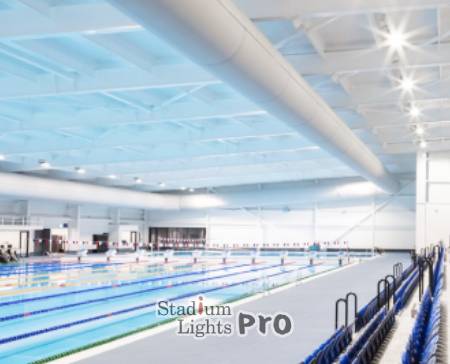 Effective natatorium lighting design necessitates meticulous consideration of several critical factors, including pool size and shape, ceiling height, viewing angles, and glare control. Collaborating with lighting designers and engineers becomes indispensable in optimizing the placement and configuration of LED fixtures to ensure both optimal performance and aesthetic appeal. By leveraging their expertise, natatoriums can develop lighting schemes tailored to their specific needs, enhancing visibility for swimmers while creating a visually appealing ambiance for spectators. Careful attention to detail in the design process enables natatoriums to mitigate potential issues such as glare and shadows, fostering a safe and comfortable environment conducive to aquatic activities and events.
Effective natatorium lighting design necessitates meticulous consideration of several critical factors, including pool size and shape, ceiling height, viewing angles, and glare control. Collaborating with lighting designers and engineers becomes indispensable in optimizing the placement and configuration of LED fixtures to ensure both optimal performance and aesthetic appeal. By leveraging their expertise, natatoriums can develop lighting schemes tailored to their specific needs, enhancing visibility for swimmers while creating a visually appealing ambiance for spectators. Careful attention to detail in the design process enables natatoriums to mitigate potential issues such as glare and shadows, fostering a safe and comfortable environment conducive to aquatic activities and events.
Waterproofing and Sealing
Due to the wet and corrosive conditions prevalent in natatorium environments, it’s crucial that LED fixtures are adequately sealed and waterproofed to prevent moisture ingress and maintain long-term reliability. Manufacturers provide a range of IP (Ingress Protection) ratings and sealing methods tailored to various application requirements, ensuring that LED fixtures can withstand the harsh conditions of natatoriums without compromising performance or safety. By selecting fixtures with appropriate IP ratings and sealing techniques, natatoriums can safeguard their lighting investment, minimize maintenance needs, and ensure uninterrupted operation, thereby enhancing both safety and operational efficiency within the facility.
Compatibility with Control Systems
Integrating LED lighting systems with advanced control technologies like dimmers, timers, and occupancy sensors presents a significant opportunity to augment energy savings and operational efficiency within natatoriums. By harnessing these control features, natatoriums can dynamically adjust lighting levels based on occupancy patterns and natural light conditions, optimizing energy usage while maintaining adequate illumination levels. Moreover, compatibility with centralized control systems like building automation systems (BAS) facilitates seamless monitoring and management of lighting across various zones within the facility. This centralized approach streamlines operations, allowing for real-time adjustments and remote access to lighting controls, ultimately enhancing overall efficiency, reducing energy costs, and contributing to a more sustainable operation of the natatorium.
Regulatory Compliance
Ensuring compliance with relevant safety and building codes is paramount in natatorium lighting installations, encompassing electrical standards, fire regulations, and accessibility requirements. Collaboration with certified lighting professionals becomes indispensable in navigating these intricate regulations, guaranteeing adherence to local codes and standards. By entrusting certified professionals with the design and implementation of natatorium lighting systems, operators can mitigate the risk of non-compliance issues and potential liabilities. These experts possess the expertise and knowledge needed to navigate complex regulatory frameworks, ensuring that lighting installations not only meet safety and accessibility standards but also operate efficiently and effectively within the natatorium environment. This proactive approach safeguards the well-being of patrons and staff while minimizing legal and financial risks associated with regulatory non-compliance.
Successful LED Natatorium Lighting Projects
Olympic Aquatics Center, London
The Olympic Aquatics Center in London, renowned for hosting the 2012 Summer Olympics, stands as a testament to cutting-edge technology with its state-of-the-art LED lighting systems meticulously engineered to meet the rigorous demands of international aquatic competitions. At the heart of this facility are custom-designed LED fixtures crafted to exacting specifications, boasting adjustable beam angles and color temperatures tailored to optimize visibility for both athletes and spectators. These advanced lighting solutions not only illuminate the expansive space with precision but also create an immersive atmosphere conducive to peak athletic performance and spectator enjoyment. By leveraging the versatility and capabilities of LED technology, the Olympic Aquatics Center sets a new standard for natatorium lighting, reaffirming its status as a world-class venue for aquatic events on the global stage.
Community Recreation Center, Anytown, USA
The Anytown Community Recreation Center’s recent upgrade of its natatorium lighting to energy-efficient LED fixtures marks a pivotal step towards sustainability and operational efficiency. Through the retrofitting of existing fixtures with LED lamps and the implementation of automated lighting controls, the center has not only realized substantial cost savings but also witnessed a notable enhancement in lighting quality. The transition to LED technology not only reduces energy consumption but also prolongs the lifespan of lighting fixtures, minimizing maintenance requirements and associated costs in the long term. By incorporating automated lighting controls, the center further optimizes energy usage, ensuring that lights are only activated when needed and dimmed during off-peak hours, thereby minimizing energy wastage. This comprehensive lighting upgrade not only benefits the facility financially but also improves the overall experience for patrons, fostering a safer, more comfortable, and sustainable environment for community members to enjoy recreational activities.
Choosing the Right Natatorium Lighting Solutions
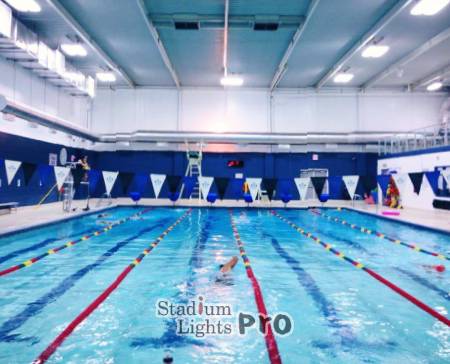 Natatoriums, indoor swimming pools, represent dynamic spaces where safety, functionality, and aesthetics intersect. Among the critical elements shaping the user experience within these environments is lighting. Illumination in natatoriums isn’t merely about visibility; it’s about creating an atmosphere conducive to performance, comfort, and even energy efficiency. In this comprehensive exploration, we delve into the intricate world of natatorium lighting, focusing on the key pillars that you must know.
Natatoriums, indoor swimming pools, represent dynamic spaces where safety, functionality, and aesthetics intersect. Among the critical elements shaping the user experience within these environments is lighting. Illumination in natatoriums isn’t merely about visibility; it’s about creating an atmosphere conducive to performance, comfort, and even energy efficiency. In this comprehensive exploration, we delve into the intricate world of natatorium lighting, focusing on the key pillars that you must know.
Understanding Lux Requirement
At the heart of effective natatorium lighting lies the concept of lux. Lux, a unit of measurement for illuminance, refers to the amount of visible light per unit area. Unlike outdoor environments where natural light often plays a dominant role, natatoriums rely predominantly on artificial lighting sources. Determining the appropriate lux levels in these indoor spaces is crucial for ensuring optimal visibility, safety, and ambiance.
Lux requirements in natatoriums are influenced by several factors. Firstly, the size and depth of the pool play a pivotal role. Larger pools and deeper water necessitate higher lux levels to ensure consistent illumination throughout the space.
Moreover, the activities conducted within the natatorium contribute to the lux equation. Whether it’s recreational swimming, training sessions, or competitive events, each scenario demands varying degrees of illumination. Furthermore, the surrounding environment, including ambient light conditions and architectural features, must be taken into account when defining lux requirements.
Industry standards provide valuable guidance regarding recommended lux levels for natatoriums. For general illumination purposes, a minimum of 300 lux is typically recommended to ensure adequate visibility and safety for swimmers and staff. However, when it comes to competitive swimming events, more stringent requirements apply. Lux levels ranging from 500 to 1500 lux are often mandated to meet specific standards and regulations, ensuring optimal conditions for athletes to perform at their best.
Achieving Uniformity in Lighting
While achieving the appropriate lux levels is essential, uniformity in lighting distribution is equally critical within natatoriums. Uniform illumination helps mitigate issues such as glare, shadows, and uneven light intensity, all of which can detract from the user experience and compromise safety.
Several challenges must be addressed to achieve uniform lighting in natatoriums. The presence of obstacles such as diving boards, starting blocks, and other equipment can disrupt the even distribution of light. Moreover, reflective surfaces, prevalent in aquatic environments, can exacerbate glare and further undermine uniformity. Additionally, the design and height of the natatorium ceiling play a significant role in how light is dispersed throughout the space.
To overcome these challenges, strategic approaches must be employed. Optimal fixture placement, taking into account the layout of the pool and potential obstacles, is crucial for achieving uniformity. By strategically positioning lighting fixtures, designers can minimize shadows and ensure consistent illumination across the entire natatorium. Furthermore, the use of diffusers and reflectors can help soften light and reduce glare, further enhancing uniformity and visual comfort for swimmers and spectators alike.
Determining the Number of Lights Required
Determining the appropriate number of lights for a natatorium involves a nuanced consideration of various factors. The luminous efficacy of lighting fixtures, measured in lumens per watt, determines their efficiency in converting electrical energy into visible light. Additionally, the specific goals of the lighting design, whether focused on recreational swimming, training sessions, or competitive events, influence the quantity of lights required.
Energy efficiency considerations also play a significant role in determining the number of lights. Balancing the desired lighting levels with energy conservation goals is essential for optimizing operational costs and minimizing environmental impact. Calculating the number of lights required involves assessing factors such as the total surface area of the pool, recommended spacing between fixtures, and the specific requirements of the intended use of the natatorium.
Case studies and real-world examples provide valuable insights into the practical application of lighting design principles in natatoriums. For a standard natatorium with moderate ceiling height and primarily recreational use, a certain number of fixtures may be recommended based on industry standards. Conversely, in facilities hosting competitive swimming events or high-intensity training sessions, a greater number of lights with higher luminous efficacy may be necessary to meet stringent lighting requirements.
Power Efficiency of LED Lighting
In recent years, Light Emitting Diode (LED) technology has emerged as the preferred lighting solution for natatoriums. LED lighting offers significant advantages over traditional lighting sources, particularly in terms of power efficiency. LEDs consume less energy while delivering higher lumen output, making them ideal for environments where lighting requirements are demanding.
One of the most compelling benefits of LED lighting is its energy efficiency. LEDs use up to 80% less energy than traditional incandescent or fluorescent lighting sources, resulting in substantial cost savings for natatorium operators. Moreover, LED fixtures have a longer lifespan, reducing maintenance and replacement costs while minimizing the environmental impact associated with frequent lamp changes.
LED lighting systems allow for precise control over power levels, enabling natatoriums to tailor illumination to specific needs. Advanced lighting controls and dimming capabilities further enhance power efficiency by adjusting light output based on usage patterns and natural light conditions. This flexibility not only saves energy but also enhances user comfort and experience within the natatorium.
Color Temperature in Natatorium Lighting
Color temperature refers to the hue of light emitted by a lighting source, measured in Kelvin (K). In natatoriums, selecting the appropriate color temperature is crucial for creating a visually appealing and functional environment. LED lighting offers a wide range of color temperature options, allowing designers to customize lighting to suit the unique requirements of the space.
The choice between warm and cool lighting temperatures depends on the desired ambiance and functionality of the natatorium. Warm white light (2700K-3500K) creates a cozy and inviting atmosphere, suitable for relaxation areas or leisure swimming. In contrast, cool white light (4000K-6500K) offers crisp visibility and enhanced color rendering, making it ideal for competitive swimming events or training sessions where precision and clarity are paramount.
LED technology enables dynamic lighting solutions that adjust color temperature based on time of day, activity levels, or user preferences. Tunable LED fixtures can mimic natural daylight cycles, promoting circadian rhythm and enhancing user well-being. Additionally, RGB (Red, Green, Blue) LED systems allow for vibrant color-changing effects, adding versatility and visual interest to natatoriums.
Anti-glare Properties of LED Lighting
Glare, caused by excessive brightness or contrast, poses a significant challenge in natatorium lighting design. Glare can obscure vision, cause discomfort, and even compromise safety, particularly in areas with reflective surfaces such as water. Addressing glare requires careful selection of lighting fixtures and control strategies to minimize its impact on swimmers and spectators.
LED fixtures offer precise control over light directionality, minimizing glare by directing light where it’s needed most. Recessed or surface-mounted fixtures with adjustable aiming angles allow designers to optimize light distribution while reducing reflections off water surfaces. Additionally, indirect lighting techniques, such as wall washing or cove lighting, can create diffuse illumination without direct glare.
Advanced diffusing and anti-glare technologies further enhance visual comfort in natatoriums. Diffusers, lenses, and frosted coatings help scatter light and reduce harsh shadows and glare. Additionally, glare-reducing optics and louvers are integrated into LED fixtures to control light output and minimize direct glare, improving overall visibility and safety within the space.
Understanding Light Pollution
Light pollution refers to the excessive or misdirected artificial light that intrudes upon natural darkness, impacting the environment, wildlife, and human health. It manifests in various forms, including skyglow, glare, and light trespass, each posing distinct challenges to ecosystems and communities.
Artificial light disrupts natural ecosystems, altering wildlife behavior, migration patterns, and reproductive cycles. Nocturnal animals, in particular, are susceptible to habitat fragmentation and disorientation caused by artificial lighting.
Exposure to artificial light at night can disrupt circadian rhythms, leading to sleep disturbances, hormonal imbalances, and adverse health effects. Additionally, excessive nighttime lighting has been linked to increased risk of obesity, diabetes, and certain cancers.
Light pollution obscures the night sky, diminishing visibility of stars and celestial objects and hindering astronomical observations. This interference not only affects scientific research but also diminishes cultural and aesthetic appreciation of the night sky.
Natatoriums present unique lighting challenges due to their proximity to water surfaces, operational hours, and the need for consistent illumination throughout the facility. Glare and reflections from water surfaces exacerbate light pollution, while the requirement for high light levels during nighttime operation further intensifies the impact on surrounding areas.
Light pollution from natatoriums contributes to environmental degradation, particularly in urban or ecologically sensitive areas. Skyglow, caused by upwardly directed light, diminishes the visibility of stars and celestial phenomena, impacting astronomy and cultural heritage. Additionally, excessive artificial lighting disrupts the behavior and ecology of nocturnal wildlife, leading to ecosystem imbalances.
Advanced Control Systems for Sustainable Lighting
Integrated control systems enable natatoriums to adjust lighting levels dynamically based on occupancy, time of day, or natural light conditions. Dimming controls allow for precise adjustment of light output, reducing energy consumption during off-peak hours while maintaining optimal visibility and safety. Additionally, scheduling and automation features streamline operations, ensuring efficient use of lighting resources without compromising user experience.
Occupancy sensors detect activity within the natatorium and adjust lighting accordingly, minimizing energy waste and light pollution during periods of low occupancy. Adaptive lighting algorithms optimize lighting levels based on real-time usage data, ensuring consistent illumination while maximizing energy efficiency and comfort for swimmers and spectators.
Conclusion
The benefits of LED natatorium lighting are multifaceted and compelling, offering solutions to the unique challenges faced by indoor swimming pool facilities. LED technology not only addresses issues such as humidity, corrosion, and uniform illumination but also provides significant advantages in terms of energy efficiency, longevity, and design flexibility. By adopting LED lighting solutions, natatoriums can realize substantial cost savings, enhance safety and comfort for patrons, and reduce their environmental footprint. Furthermore, the integration of LED lighting with smart technologies opens up new possibilities for optimizing energy usage, enhancing user experience, and automating maintenance tasks. As sustainability continues to gain importance in building design and operations, LED natatorium lighting emerges as a sustainable and future-proof solution, paving the way for greener and more efficient facilities in the years to come.

